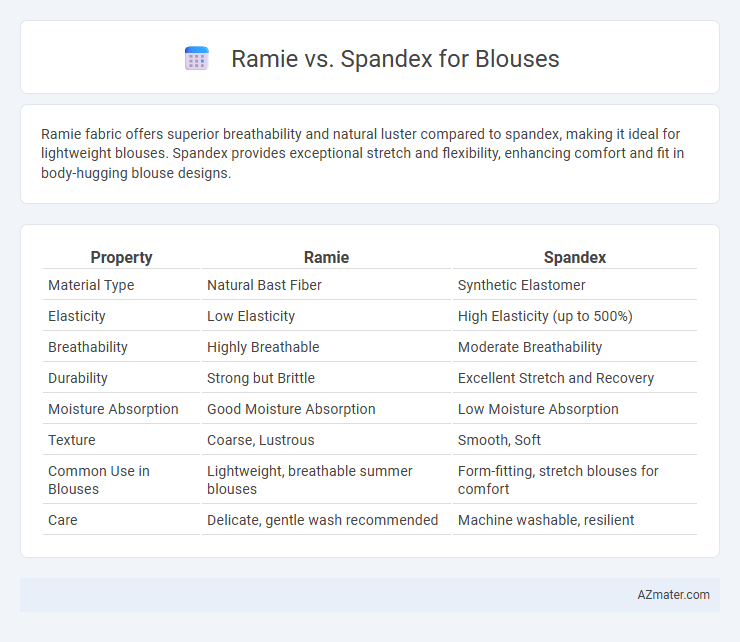Ramie fabric offers superior breathability and natural luster compared to spandex, making it ideal for lightweight blouses. Spandex provides exceptional stretch and flexibility, enhancing comfort and fit in body-hugging blouse designs.
Table of Comparison
| Property | Ramie | Spandex |
|---|---|---|
| Material Type | Natural Bast Fiber | Synthetic Elastomer |
| Elasticity | Low Elasticity | High Elasticity (up to 500%) |
| Breathability | Highly Breathable | Moderate Breathability |
| Durability | Strong but Brittle | Excellent Stretch and Recovery |
| Moisture Absorption | Good Moisture Absorption | Low Moisture Absorption |
| Texture | Coarse, Lustrous | Smooth, Soft |
| Common Use in Blouses | Lightweight, breathable summer blouses | Form-fitting, stretch blouses for comfort |
| Care | Delicate, gentle wash recommended | Machine washable, resilient |
Introduction to Ramie and Spandex Fabrics
Ramie is a natural fiber derived from the stalks of the Chinese nettle plant, known for its strength, breathability, and moisture-wicking properties, making it suitable for lightweight, summer blouses. Spandex, a synthetic fiber recognized for its exceptional elasticity and recovery, provides stretch and comfort, enhancing the fit and mobility of blouse fabrics. Combining ramie with spandex in blouse construction offers a balance of natural texture and durability with flexible, form-fitting performance.
Origin and Production Processes
Ramie is a natural fiber derived from the stalks of the Chinese nettle plant, primarily cultivated in China, Brazil, and the Philippines, involving processes like harvesting, retting to separate fibers, and degumming to remove gummy substances. Spandex, also known as elastane, is a synthetic fiber created through a complex chemical process of polymerization, primarily produced in factories using polyurethane-based raw materials sourced from petrochemicals. The distinct origins and production methods significantly influence their texture, durability, and elasticity, making ramie breathable and smooth, while spandex offers exceptional stretch and shape retention for blouses.
Key Properties and Characteristics
Ramie is a natural fiber known for its strength, breathability, and lustrous appearance, making it ideal for lightweight, breathable blouses with a crisp texture. Spandex, a synthetic fiber, offers exceptional elasticity and shape retention, providing stretch and comfort in close-fitting blouses. Combining ramie's durability and spandex's flexibility creates garments that balance breathability with form-fitting support.
Comfort and Wearability in Blouses
Ramie fabric offers excellent breathability and natural moisture-wicking properties, making it highly comfortable for blouses in warm weather. Spandex provides superior stretch and recovery, enhancing wearability by allowing freedom of movement and maintaining garment shape throughout the day. Combining ramie and spandex in blouse fabrics delivers a balance of comfort, durability, and flexible fit, ideal for all-day wear.
Breathability and Moisture Management
Ramie fabric offers exceptional breathability due to its natural fiber structure, allowing air to flow freely and keeping the wearer cool in warm conditions. Its high moisture-absorbing ability wicks sweat away from the skin, promoting quick drying and enhanced comfort. Spandex, while known for its stretch and flexibility, has limited breathability and moisture management, often relying on blends with other fibers to improve ventilation and moisture-wicking performance.
Durability and Longevity Comparison
Ramie fabric offers superior durability due to its natural fiber strength, making it resistant to wear and tear for blouses exposed to frequent use. Spandex, while providing excellent elasticity and comfort, tends to lose its stretch over time, reducing the garment's lifespan. For long-lasting blouses, ramie is preferred for maintaining structural integrity, whereas spandex is better suited for styles prioritizing flexibility.
Eco-Friendliness and Sustainability
Ramie fabric, derived from natural plant fibers, offers superior eco-friendliness due to its biodegradability and low resource-intensive cultivation process compared to synthetic spandex, which is petroleum-based and non-biodegradable. Spandex production involves energy-intensive chemical processes and contributes to microplastic pollution, making it less sustainable over its lifecycle. Choosing ramie for blouses supports sustainable fashion practices by reducing environmental impact and promoting renewable fiber use.
Style Versatility and Blouse Design
Ramie fabric offers a natural, crisp texture that enhances blouse designs with a structured and breathable quality, ideal for casual to semi-formal styles. Spandex provides exceptional stretch and recovery, enabling form-fitting blouses that adapt to various body shapes while maintaining comfort and movement. Combining ramie's durability with spandex's elasticity results in versatile blouses that balance style flexibility and sleek silhouette performance.
Care, Maintenance, and Cleaning
Ramie fabric, derived from the nettle plant fiber, requires gentle hand washing and air drying to prevent stiffness and preserve its natural luster, avoiding bleach and high heat to maintain fiber integrity. In contrast, spandex blends used in blouses benefit from machine washing in cold water on a delicate cycle and air drying to retain elasticity and prevent fiber damage. Both fabrics should avoid ironing with high heat; instead, use low-temperature settings for spandex and steaming for ramie to keep the blouse in optimal condition.
Choosing the Best Fabric for Your Blouse Needs
Ramie fabric offers excellent breathability and durability, making it ideal for lightweight, eco-friendly blouses that require natural fiber benefits and moisture-wicking properties. Spandex provides superior stretch and shape retention, perfect for form-fitting blouses that demand flexibility and comfort during movement. Choose ramie for a crisp, breathable look and spandex for a sleek, stretchy fit tailored to active wear or body-conscious styles.

Infographic: Ramie vs Spandex for Blouse
 azmater.com
azmater.com